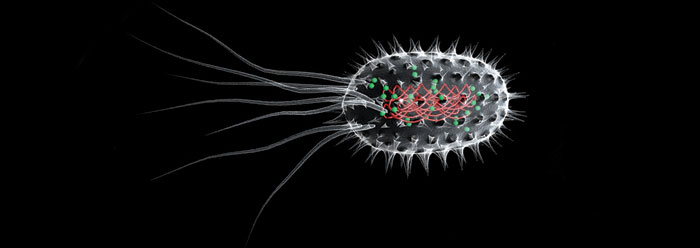Bacteria (prokaryotes) are found everywhere and are a critical foundation of the earth's ecosystem. The prokaryotes are designed to be saprotrophs or "decomposers," breaking down wastes and organic material so that chemical components such as nitrogen can be recycled.
Evolutionary theory states that some ancient prokaryotes ("simple" forms) evolved into eukaryotes ("complex" forms). Eukaryotes are cells with a membranebound nucleus and DNA structured into linear chromosomes, versus the circular chromosomes in bacteria. However, the Creator has designed bacteria with some amazing properties that should cause one to be openly skeptical of Darwinian claims regarding bacteria's origin and alleged evolution over time into completely different life forms. (For example, see my article "Just How Simple Are Bacteria?"1)
Secular scientists have no credible idea how the DNA molecule may have evolved from non-life--especially without the aid of proteins (which must be coded by DNA2) or the critical DNA repair system.3
The genetic material (DNA) in most bacteria is found as a single circular chromosome in an area called the nucleoid region and contains some 4.7 million base pairs. Stretched out, this DNA molecule would be about 1,000 times longer than the bacterium itself. The bacterial chromosome, though chemically identical, is structured unlike linear chromosomes of eukaryotic cells that make up people (46 chromosomes), plants (e.g., corn, 20 chromosomes) and animals (e.g., fruit fly, 8 chromosomes).
All cells (except mature red blood cells) must duplicate their genetic material for the next generation. The process of DNA duplication in bacteria, called replication, into two exact copies--one for each new daughter cell--is quite complex. This involves an origin site on the circular molecule (called oriC) where replication begins. Then, bidirectional replication of the two strands at identical speeds is carried out with precision. As you can see, this is hardly simple and involves many enzymes, including topoisomerases. These large molecules are designed with the important job of relaxing and uncoiling the DNA. Some anti-cancer drugs work by interfering with topoisomerases in targeted cancer cells.
As impossible as it would have been for such a process to have evolved through time, chance, and random genetic mistakes, three evolutionists ask if DNA replication could have evolved twice independently!4
Replication difficulties aside, fitting the convoluted mass of DNA in the confines of a tiny bacterium requires an amazing process called supercoiling. The Creator has designed enzymes that rapidly and efficiently twist the bacterial DNA upon itself. For example, Type II topoisomerases (DNA gyrase that produces negatively supercoiled DNA by cutting it) maintain a precise, steady-state degree of supercoiling. Fully supercoiled, the chromosome is about 1 μm (a micrometer, 1 millionth of a meter) in diameter, while its relaxed configuration is approximately 430 μm.
Far from supercoiling just being an efficient manner in which the bacterium stores its DNA, researchers are discovering that "supercoiling acts as a second messenger that transmits information about the environment to many regulatory networks in the cell."5 A second messenger (e.g., cyclic AMP) is an intermediary compound that can alter fundamental patterns of gene (DNA) expression.
So, not only must the DNA of bacteria replicate error-free at an amazing rate (30,000 "letters" per minute), but it must also be compacted to fit inside an impossibly small space. During replication, certain genes must also be immediately available for necessary bacterial functions, some actually being expressed by their sensitivity to supercoiling--which in turn is stimulated by environmental changes. And this is just the "simple" bacterium. As we say in creation science, "If it's living--it's complex!"
References
- Sherwin, F. 2001. Just How Simple Are Bacteria? Acts & Facts. 30 (2).
- See Sherwin, F. 2002. The Egg/Chicken Conundrum. Acts & Facts. 31 (5).
- See Sherwin, F. 2004. Mending Mistakes--The Amazing Ability of Repair. Acts & Facts. 33 (6).
- Leipe, D.D., L. Aravind, and E.V. Koonin. 1999. Did DNA replication evolve twice independently? Nucleic Acids Research. 27 (17): 3389-3401.
- Peter, B.J., et al. 2004. Genomic transcriptional response to loss of chromosomal supercoiling in Escherichia coli. Genome Biology. 5 (11): R87.
* Mr. Sherwin is Science Editor.
Cite this article: Sherwin, F. 2008. Tiny Bacteria's Big Challenge to Darwin. Acts & Facts. 37 (7): 13.














